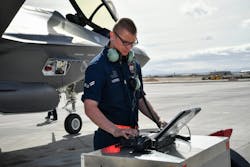Air Force asks Lockheed Martin to provide logistics and mission planning computers for F-35 combat aircraft
PATUXENT RIVER NAS, Md. – U.S. Navy combat aircraft experts needed logistics and mission-planning computer hardware for the F-35 Lightning II joint strike fighter. They found their solution from Lockheed Martin Corp. Aeronautics segment in Fort Worth, Texas.
Officials of the Naval Air Systems Command at Patuxent River Naval Air Station, Md., have announced a $152.3 million contract to provide F-35 logistics information systems to include Autonomic Logistics Information System (ALIS), Operational Data Integrated Network (ODIN), and Mission Planning Environment (MPE) hardware.
ODIN is a cloud-native computer logistics sustainment system with an integrated data environment and user applications that improve F-35 sustainment and readiness.
This contract includes contract management, planning and readiness reviews, and non-recurring introduction to help field the F-35 ODIN, MPE, and components of any future ODIN and MPE retrofits for the F-35A, F-35B, and F-35C combat aircraft.
ODIN is to supersede Lockheed Martin’s ALIS by the end of this year when all F-35 units are scheduled to have ODIN computers and software. The F-35 MPE consists of developed applications built from a framework, common components, and unique planning components.
F-35 pilots, maintainers, and support personnel have been using ALIS to track and order spare parts, conduct repairs, support mission planning and training, and store technical data. Still, ALIS was designed with the jet in the early 2000s, and some of its technology has become outdated; today it creates a system that is slow and difficult to use.
ODIN is being designed to decrease F-35 administrator and maintainer workload, increase mission capability all F-35 variants, and enable engineers to develop and deploy software updates rapidly.
ODIN will combine Lockheed Martin computer and networking hardware with software coded by the government to enable military experts to retain control over the system.
Related: SAIC wins contract for Air Force mission planning system
The new ODIN hardware is much smaller than the servers and the computers that support ALIS. Existing ALIS servers can weigh more than 800 pounds require a six-foot rack of electronics and backup power modules, which makes it difficult to deploy ALIS in austere environments near the front lines.
ODIN hardware, on the other hand, has two transportable cases about the size of two pieces of carry-on luggage that collectively weigh about 140 pounds. ALIS software also runs about twice as fast on the ODIN computers than it did on the old hardware.
The F-35 is the first tactical aircraft with sustainment tools designed together with the aircraft to help control the costs of maintaining a fleet of 5th generation jet fighters.
On this order Lockheed Martin will do the work in Orlando, Fla., and Fort Worth, Texas, and should be finished by December 2024. For more information contact Lockheed Martin Aeronautics online at www.lockheedmartin.com/en-us/who-we-are/business-areas/aeronautics.html, or Naval Air Systems Command at www.navair.navy.mil.
About the Author
John Keller
Editor-in-Chief
John Keller is the Editor-in-Chief, Military & Aerospace Electronics Magazine--provides extensive coverage and analysis of enabling electronics and optoelectronic technologies in military, space and commercial aviation applications. John has been a member of the Military & Aerospace Electronics staff since 1989 and chief editor since 1995.
